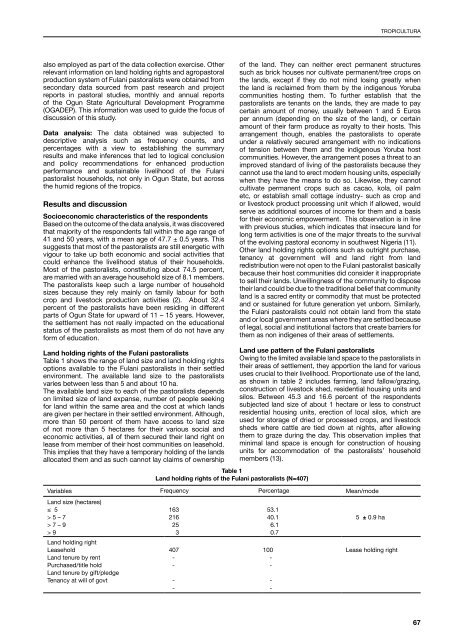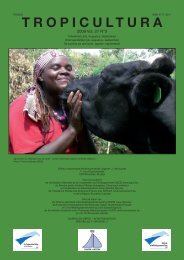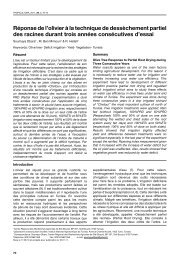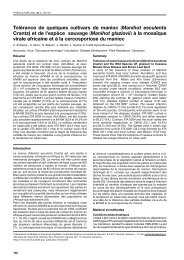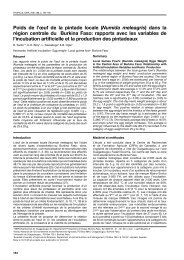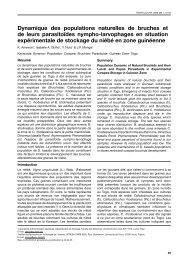Fascicule entier - Tropicultura
Fascicule entier - Tropicultura
Fascicule entier - Tropicultura
You also want an ePaper? Increase the reach of your titles
YUMPU automatically turns print PDFs into web optimized ePapers that Google loves.
also employed as part of the data collection exercise. Other<br />
relevant information on land holding rights and agropastoral<br />
production system of Fulani pastoralists were obtained from<br />
secondary data sourced from past research and project<br />
reports in pastoral studies, monthly and annual reports<br />
of the Ogun State Agricultural Development Programme<br />
(OGADEP). This information was used to guide the focus of<br />
discussion of this study.<br />
Data analysis: The data obtained was subjected to<br />
descriptive analysis such as frequency counts, and<br />
percentages with a view to establishing the summary<br />
results and make inferences that led to logical conclusion<br />
and policy recommendations for enhanced production<br />
performance and sustainable livelihood of the Fulani<br />
pastoralist households, not only in Ogun State, but across<br />
the humid regions of the tropics.<br />
Results and discussion<br />
Socioeconomic characteristics of the respondents<br />
Based on the outcome of the data analysis, it was discovered<br />
that majority of the respondents fall within the age range of<br />
41 and 50 years, with a mean age of 47.7 ± 0.5 years. This<br />
suggests that most of the pastoralists are still energetic with<br />
vigour to take up both economic and social activities that<br />
could enhance the livelihood status of their households.<br />
Most of the pastoralists, constituting about 74.5 percent,<br />
are married with an average household size of 8.1 members.<br />
The pastoralists keep such a large number of household<br />
sizes because they rely mainly on family labour for both<br />
crop and livestock production activities (2). About 32.4<br />
percent of the pastoralists have been residing in different<br />
parts of Ogun State for upward of 11 – 15 years. However,<br />
the settlement has not really impacted on the educational<br />
status of the pastoralists as most them of do not have any<br />
form of education.<br />
Land holding rights of the Fulani pastoralists<br />
Table 1 shows the range of land size and land holding rights<br />
options available to the Fulani pastoralists in their settled<br />
environment. The available land size to the pastoralists<br />
varies between less than 5 and about 10 ha.<br />
The available land size to each of the pastoralists depends<br />
on limited size of land expanse, number of people seeking<br />
for land within the same area and the cost at which lands<br />
are given per hectare in their settled environment. Although,<br />
more than 50 percent of them have access to land size<br />
of not more than 5 hectares for their various social and<br />
economic activities, all of them secured their land right on<br />
lease from member of their host communities on leasehold.<br />
This implies that they have a temporary holding of the lands<br />
allocated them and as such cannot lay claims of ownership<br />
Table 1<br />
Land holding rights of the Fulani pastoralists (N=407)<br />
Variables Frequency Percentage<br />
Mean/mode<br />
Land size (hectares)<br />
≤ 5<br />
> 5 – 7<br />
> 7 – 9<br />
> 9<br />
Land holding right<br />
Leasehold<br />
Land tenure by rent<br />
Purchased/title hold<br />
Land tenure by gift/pledge<br />
Tenancy at will of govt<br />
163<br />
216<br />
25<br />
3<br />
407<br />
-<br />
-<br />
-<br />
-<br />
53.1<br />
40.1<br />
6.1<br />
0.7<br />
100<br />
-<br />
-<br />
-<br />
-<br />
5 ± 0.9 ha<br />
Lease holding right<br />
TROPICULTURA<br />
of the land. They can neither erect permanent structures<br />
such as brick houses nor cultivate permanent/tree crops on<br />
the lands, except if they do not mind losing greatly when<br />
the land is reclaimed from them by the indigenous Yoruba<br />
communities hosting them. To further establish that the<br />
pastoralists are tenants on the lands, they are made to pay<br />
certain amount of money, usually between 1 and 5 Euros<br />
per annum (depending on the size of the land), or certain<br />
amount of their farm produce as royalty to their hosts. This<br />
arrangement though, enables the pastoralists to operate<br />
under a relatively secured arrangement with no indications<br />
of tension between them and the indigenous Yoruba host<br />
communities. However, the arrangement poses a threat to an<br />
improved standard of living of the pastoralists because they<br />
cannot use the land to erect modern housing units, especially<br />
when they have the means to do so. Likewise, they cannot<br />
cultivate permanent crops such as cacao, kola, oil palm<br />
etc, or establish small cottage industry- such as crop and<br />
or livestock product processing unit which if allowed, would<br />
serve as additional sources of income for them and a basis<br />
for their economic empowerment. This observation is in line<br />
with previous studies, which indicates that insecure land for<br />
long term activities is one of the major threats to the survival<br />
of the evolving pastoral economy in southwest Nigeria (11).<br />
Other land holding rights options such as outright purchase,<br />
tenancy at government will and land right from land<br />
redistribution were not open to the Fulani pastoralist basically<br />
because their host communities did consider it inappropriate<br />
to sell their lands. Unwillingness of the community to dispose<br />
their land could be due to the traditional belief that community<br />
land is a sacred entity or commodity that must be protected<br />
and or sustained for future generation yet unborn. Similarly,<br />
the Fulani pastoralists could not obtain land from the state<br />
and or local government areas where they are settled because<br />
of legal, social and institutional factors that create barriers for<br />
them as non indigenes of their areas of settlements.<br />
Land use pattern of the Fulani pastoralists<br />
Owing to the limited available land space to the pastoralists in<br />
their areas of settlement, they apportion the land for various<br />
uses crucial to their livelihood. Proportionate use of the land,<br />
as shown in table 2 includes farming, land fallow/grazing,<br />
construction of livestock shed, residential housing units and<br />
silos. Between 45.3 and 16.6 percent of the respondents<br />
subjected land size of about 1 hectare or less to construct<br />
residential housing units, erection of local silos, which are<br />
used for storage of dried or processed crops, and livestock<br />
sheds where cattle are tied down at nights, after allowing<br />
them to graze during the day. This observation implies that<br />
minimal land space is enough for construction of housing<br />
units for accommodation of the pastoralists’ household<br />
members (13).<br />
67


